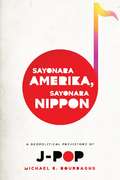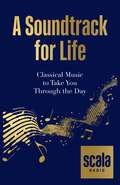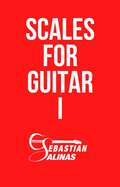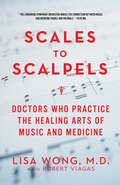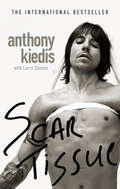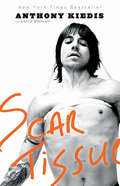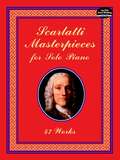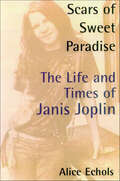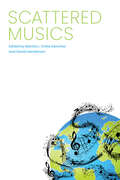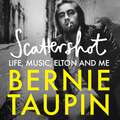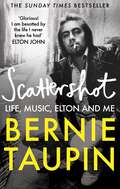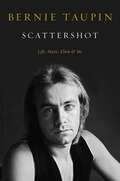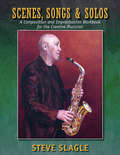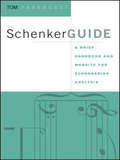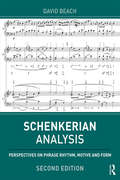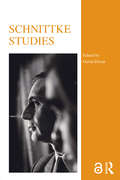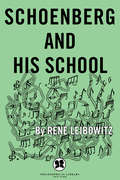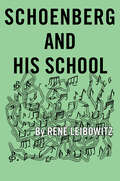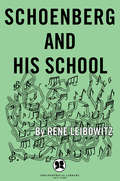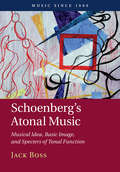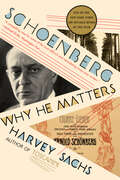- Table View
- List View
Sayonara Amerika, Sayonara Nippon: A Geopolitical Prehistory of J-Pop (Asia Perspectives: History, Society, and Culture)
by Michael BourdaghsFrom the beginning of the American Occupation in 1945 to the post-bubble period of the early 1990s, popular music provided Japanese listeners with a much-needed release, channeling their desires, fears, and frustrations into a pleasurable and fluid art. Pop music allowed Japanese artists and audiences to assume various identities, reflecting the country's uncomfortable position under American hegemony and its uncertainty within ever-shifting geopolitical realities. In the first English-language study of this phenomenon, Michael K. Bourdaghs considers genres as diverse as boogie-woogie, rockabilly, enka, 1960s rock and roll, 1970s new music, folk, and techno-pop. Reading these forms and their cultural import through music, literary, and cultural theory, he introduces readers to the sensual moods and meanings of modern Japan. As he unpacks the complexities of popular music production and consumption, Bourdaghs interprets Japan as it worked through (or tried to forget) its imperial past. These efforts grew even murkier as Japanese pop migrated to the nation's former colonies. In postwar Japan, pop music both accelerated and protested the commodification of everyday life, challenged and reproduced gender hierarchies, and insisted on the uniqueness of a national culture, even as it participated in an increasingly integrated global marketplace. Each chapter in Sayonara Amerika, Sayonara Nippon examines a single genre through a particular theoretical lens: the relation of music to liberation; the influence of cultural mapping on musical appreciation; the role of translation in transmitting musical genres around the globe; the place of noise in music and its relation to historical change; the tenuous connection between ideologies of authenticity and imitation; the link between commercial success and artistic integrity; and the function of melodrama. Bourdaghs concludes with a look at recent Japanese pop music culture.
Scala Radio's A Soundtrack for Life: Classical Music to Take You Through the Day
by Scala RadioBringing together much-loved masterpieces with exciting new works, this accessible and inspiring guide is a celebration of classical music. With pieces ranging from Vaughan Williams's The Lark Ascending and Beethoven's Pastoral Symphony to the scores for Avatar and Assassin's Creed, each entry puts the piece of music into context, providing fascinating insights into the inspirations behind each work and enhancing your listening experience. Organised into Occasions and Themes, the book features music to accompany you through your day, from getting up and getting dressed to running, reading, walking the dog, cooking, taking a bath, going to sleep and everything in between. You'll also find expert curations of the world's most romantic music and the greatest Christmas choral works as well as compositions that celebrate the natural world and mark births and marriages. Perfect for classical music enthusiasts as well as anyone looking for an enjoyable introduction to this genre, this is the definitive modern guide to classical music.
Scala Radio's A Soundtrack for Life: Classical Music to Take You Through the Day
by Scala RadioBringing together much-loved masterpieces with exciting new works, this accessible and inspiring guide is a celebration of classical music. With pieces ranging from Vaughan Williams's The Lark Ascending and Beethoven's Pastoral Symphony to the scores for Avatar and Assassin's Creed, each entry puts the piece of music into context, providing fascinating insights into the inspirations behind each work and enhancing your listening experience. Organised into Occasions and Themes, the book features music to accompany you through your day, from getting up and getting dressed to running, reading, walking the dog, cooking, taking a bath, going to sleep and everything in between. You'll also find expert curations of the world's most romantic music and the greatest Christmas choral works as well as compositions that celebrate the natural world and mark births and marriages. Perfect for classical music enthusiasts as well as anyone looking for an enjoyable introduction to this genre, this is the definitive modern guide to classical music.
Scales for Guitar I
by Sebastian SalinasScales for Guitar I presents exercises to help you easily learn the major and minor pentatonic and diatonic scales. Learning the scales on a guitar is of the utmost importance for your skills of improvisation and composition. Each of the four scales covered in this book are shown in five positions on the fretboard of the guitar. The goal is that you will know and immediately see all five positions as a single great pattern that covers all strings on your guitar. Practicing these scales in the five positions will give you a deeper understanding of the fretboard and thus improve your guitar playing skills.
Scales to Scalpels
by Lisa WongA Simon & Schuster eBook. Simon & Schuster has a great book for every reader.
Scar Tissue
by Anthony KiedisIn SCAR TISSUE Anthony Kiedis, charismatic and highly articulate frontman of the Red Hot Chili Peppers, recounts his remarkable life story, and the history of the band itself. Raised in the Midwest, he moved to LA aged eleven to live with his father Blackie, purveyor of pills, pot, and cocaine to the Hollywood elite. After a brief child-acting career, Kiedis dropped out of U.C.L.A. and plunged headfirst into the demimonde of the L.A. underground music scene. He formed the band with three schoolfriends - and found his life's purpose. Crisscrossing the country, the Chili Peppers were musical innovators and influenced a whole generation of musicians. But there's a price to pay for both success and excess and in SCAR TISSUE, Kiedis writes candidly of the overdose death of his soul mate and band mate, Hillel Slovak, and his own ongoing struggle with an addiction to drugs.SCAR TISSUE far transcends the typical rock biography, because Anthony Kiedis is anything but a typical rock star. It is instead a compelling story of dedication and debauchery, of intrigue and integrity, of recklessness and redemption.
Scar Tissue: Der Sänger Der Red Hot Chili Peppers - Die Autobiographie
by Larry Sloman Anthony KiedisThe New York Times bestseller by one of rock's most provocative figuresScar Tissue is Anthony Kiedis's searingly honest memoir of a life spent in the fast lane. In 1983, four self-described "knuckleheads" burst out of the mosh-pitted mosaic of the neo-punk rock scene in L.A. with their own unique brand of cosmic hardcore mayhem funk. Over twenty years later, the Red Hot Chili Peppers, against all odds, have become one of the most successful bands in the world. Though the band has gone through many incarnations, Anthony Kiedis, the group's lyricist and dynamic lead singer, has been there for the whole roller-coaster ride.Whether he's recollecting the influence of the beautiful, strong women who have been his muses, or retracing a journey that has included appearances as diverse as a performance before half a million people at Woodstock or an audience of one at the humble compound of the exiled Dalai Lama, Kiedis shares a compelling story about the price of success and excess. Scar Tissue is a story of dedication and debauchery, of intrigue and integrity, of recklessness and redemption--a story that could only have come out of the world of rock.
Scarlatti Masterpieces for Solo Piano: 47 Works (Dover Classical Piano Music)
by Domenico ScarlattiBorn in the same year as Johann Sebastian Bach, Domenico Scarlatti strongly influenced subsequent trends in keyboard music through his uniquely elegant, embellished, fleet virtuoso style. This new compilation of popular selections by the great master presents favorites drawn from his more than 500 miniature sonatas.All of Scarlatti's familiar and best-loved masterpieces -- well-known worldwide from piano recitals and CDs -- appear here: tarantellas, Siciliennes, pastorals, and sparkling high-speed keyboard toccatas of the greatest ingenuity.According to legendary keyboard artist Wanda Landowska, "when we hear Scarlatti's music, we know that we are in the climate of sunlight and warmth. It is Italy, it is Spain -- the spirit of the Latin countries and the god of the Mediterranean." Pianists and all music lovers can discover the truth of that statement in this handsome and inexpensive compilation of exquisite pieces.
Scars of Sweet Paradise: The Life and Times of Janis Joplin
by Alice EcholsJanis Joplin was the skyrocket chick of the sixties, the woman who broke into the boys' club of rock and out of the stifling good-girl femininity of postwar America. With her incredible wall-of-sound vocals, Joplin was the voice of a generation, and when she OD'd on heroin in October 1970, a generation's dreams crashed and burned with her. Alice Echols pushes past the legary Joplin-the red-hot mama of her own invention-as well as the familiar portrait of the screwed-up star victimized by the era she symbolized, to examine the roots of Joplin's muscianship and explore a generation's experiment with high-risk living and the terrible price it exacted.A deeply affecting biography of one of America's most brilliant and tormented stars, Scars of Sweet Paradise is also a vivid and incisive cultural history of an era that changed the world for us all.
Scattered Musics
by Martha I. Chew Sánchez and David HendersonContributions by Nilanjana Bhattacharjya, Benjamin Burkhart, Ivy Chevers, Martha I. Chew Sánchez, Athena Elafros, William García-Medina, Sara Goek, David Henderson, Eyvind Kang, Junko Oba, Juan David Rubio Restrepo, and Gareth Dylan SmithIn Scattered Musics, editors Martha I. Chew Sánchez and David Henderson, along with a range of authors from a variety of scholarly backgrounds, consider the musics that diaspora and migrant populations are inspired to create, how musics and musicians travel, and how they change in transit. The authors cover a lot of ground: cumbia in Mexico, música sertaneja in Japan, hip-hop in Canada, Irish music in the US and the UK, reggae and dancehall in Germany, and more. Diasporic groups transform the musical expressions of their home countries as well as those in their host communities. The studies collected here show how these transformations are ways of grappling with ever-changing patterns of movement. Different diasporas hold their homelands in different regards. Some communities try to re-create home away from home in musical performances, while others use music to critique and redefine their senses of home. Through music, people seek to reconstruct and refine collective memory and a collective sense of place.The essays in this volume—by sociologists, historians, ethnomusicologists, and others—explore these questions in ways that are theoretically sophisticated yet readable, making evident the complexities of musical and social phenomena in diaspora and migrant populations. As the opening paragraph of the introduction to the volume observes, “What remains when people have been scattered apart is a strong urge to gather together, to collect.” At few times in our lives has that ever been more apparent than right now.
Scattershot: Life, Music, Elton and Me
by Bernie Taupin'This is the most glorious of books. I am besotted by the life I never knew he had.' -Elton John'Orgasmic. Every page of Scattershot is a delight, a joy, a name-dropper fan's delight. Divine. I couldn't put it down.' -Pete Townshend'In Bernie Taupin's miraculous memoir Scattershot you'll meet legends, cowboys, geniuses, unforgettable faces in the night, shady purveyors of outrageous fortune, warriors of the heart, and most of all, Taupin himself. Hilarious and so emotionally true, Scattershot is like a letter from a cherished friend. You'll want to keep it close, so you can read it again and again.' -Cameron Crowe'Touching. Charming. Humble. Witty. And exquisitely written. Taupin's words need no musical accompaniment. They sing with a poets voice.' -Gary Oldman'Eloquent and inspiring, Scattershot is a freewheeling memoir that is as warm and evocative as Bernie Taupin's most memorable lyrics. A born storyteller, Taupin gives us the life of an artist whose outlook was shaped by a rare but fascinating blend of lifelong innocence and endless intellectual curiosity.' -Robert Hilburn, author of Johnny Cash: The Life"I loved writing, I loved chronicling life and every moment I was cogent, sober, or blitzed, I was forever feeding off my surroundings, making copious notes as ammunition for future compositions. . . . The thing is good, bad or indifferent I never stopped writing, it was as addictive as any drug."This is the memoir music fans have been waiting for. Half of one of the greatest creative partnerships in popular music, Bernie Taupin is the man who wrote the lyrics for Elton John, who conceived the ideas that spawned countless hits, and sold millions and millions of records. Together, they were a duo, a unit, an immovable object. Their extraordinary, half-century-and-counting creative relationship has been chronicled in biopics (like 2019's Rocketman) and even John's own autobiography, Me. But Taupin, a famously private person, has kept his own account of their adventures close to his chest, until now.Written with honesty and candour, Scatterhot allows the reader to witness events unfolding from Taupin's singular perspective, sometimes front and center, sometimes from the edge, yet always described vibrantly, with an infectious energy that only a vivid songwriter's prose could offer. From his childhood in the East Midlands of England whose imagination was sparked and forever informed by the distinctly American mythopoetics of country music and cowboys, to the glittering, star-studded fishbowl of '70s and '80s Beverly Hills, Scattershot is simultaneously a Tom Jones-like picaresque journey across a landscape of unforgettable characters, as well as a striking, first-hand account of a creative era like no other and one man's experience at the core of it.An exciting, multi-decade whirlwind, Scattershot whizzes around the world as we ride shotgun with Bernie on his extraordinary life. We visit New York with him and Elton on the cusp of global fame. We spend time with him in Australia almost in residency at an infamous rock 'n' roll hotel in an endless blizzard of drugs. And we spend late, late night hours with John Lennon, with Bob Marley, and hanging with Frank Sinatra. And beyond the world of popular music, we witness memorable encounters with writers like Graham Greene, painters like Andy Warhol and Salvador Dali, and scores of notable misfits, miscreants, eccentrics, and geniuses, known and unknown. Even if they're not famous in their own right, they are stars on the page, and we discover how they inspired the indelible lyrics to songs such as "Tiny Dancer," "Candle in the Wind," "Bennie and The Jets," and so many more.Unique and utterly compelling, Scattershot will transport the reader across the decades and around the globe, along the way meeting some of the greatest creative minds of the 20th century, and in
Scattershot: Life, Music, Elton and Me
by Bernie Taupin'This is the most glorious of books. I am besotted by the life I never knew he had.' -Elton John'Orgasmic. Every page of Scattershot is a delight, a joy, a name-dropper fan's delight. Divine. I couldn't put it down.' -Pete Townshend'In Bernie Taupin's miraculous memoir Scattershot you'll meet legends, cowboys, geniuses, unforgettable faces in the night, shady purveyors of outrageous fortune, warriors of the heart, and most of all, Taupin himself. Hilarious and so emotionally true, Scattershot is like a letter from a cherished friend. You'll want to keep it close, so you can read it again and again.' -Cameron Crowe'Touching. Charming. Humble. Witty. And exquisitely written. Taupin's words need no musical accompaniment. They sing with a poets voice.' -Gary Oldman'Eloquent and inspiring, Scattershot is a freewheeling memoir that is as warm and evocative as Bernie Taupin's most memorable lyrics. A born storyteller, Taupin gives us the life of an artist whose outlook was shaped by a rare but fascinating blend of lifelong innocence and endless intellectual curiosity.' -Robert Hilburn, author of Johnny Cash: The LifeThis is the memoir music fans have been waiting for. Half of one of the greatest creative partnerships in popular music, Bernie Taupin is the man who wrote the lyrics for Elton John, who conceived the ideas that spawned countless hits, and sold millions and millions of records. Together, they were a duo, a unit, an immovable object. Their extraordinary, half-century-and-counting creative relationship has been chronicled in biopics (like 2019's Rocketman) and even John's own autobiography, Me. But Taupin, a famously private person, has kept his own account of their adventures close to his chest, until now.Written with honesty and candour, Scatterhot allows the reader to witness events unfolding from Taupin's singular perspective, sometimes front and center, sometimes from the edge, yet always described vibrantly, with an infectious energy that only a vivid songwriter's prose could offer. From his childhood in the East Midlands of England whose imagination was sparked and forever informed by the distinctly American mythopoetics of country music and cowboys, to the glittering, star-studded fishbowl of '70s and '80s Beverly Hills, Scattershot is simultaneously a Tom Jones-like picaresque journey across a landscape of unforgettable characters, as well as a striking, first-hand account of a creative era like no other and one man's experience at the core of it.An exciting, multi-decade whirlwind, Scattershot whizzes around the world as we ride shotgun with Bernie on his extraordinary life. We visit New York with him and Elton on the cusp of global fame. We spend time with him in Australia almost in residency at an infamous rock 'n' roll hotel in an endless blizzard of drugs. And we spend late, late night hours with John Lennon, with Bob Marley, and hanging with Frank Sinatra. And beyond the world of popular music, we witness memorable encounters with writers like Graham Greene, painters like Andy Warhol and Salvador Dali, and scores of notable misfits, miscreants, eccentrics, and geniuses, known and unknown. Even if they're not famous in their own right, they are stars on the page, and we discover how they inspired the indelible lyrics to songs such as "Tiny Dancer," "Candle in the Wind," "Bennie and The Jets," and so many more.Unique and utterly compelling, Scattershot will transport the reader across the decades and around the globe, along the way meeting some of the greatest creative minds of the 20th century, and into the vivid imaginings of one of music's most legendary lyricists.
Scattershot: Life, Music, Elton, and Me
by Bernie Taupin**NEW YORK TIMES BESTSELLER** An evocative, clear-eyed, and revealing memoir by Bernie Taupin, the lyrical master and long-time collaborator of Elton John&“I loved writing, I loved chronicling life and every moment I was cogent, sober, or blitzed, I was forever feeding off my surroundings, making copious notes as ammunition for future compositions. . . . The thing is good, bad, or indifferent I never stopped writing, it was as addictive as any drug.&” This is the memoir music fans have been waiting for. Half of one of the greatest creative partnerships in popular music, Bernie Taupin is the man who wrote the lyrics for Elton John, who conceived the ideas that spawned countless hits, and sold millions and millions of records. Together, they were a duo, a unit, an immovable object. Their extraordinary, half-century-and-counting creative relationship has been chronicled in biopics (like 2019's Rocketman) and even John's own autobiography, Me. But Taupin, a famously private person, has kept his own account of their adventures close to his chest, until now. Written with honesty and candor, Scattershot allows the reader to witness events unfolding from Taupin's singular perspective, sometimes front and center, sometimes from the edge, yet always described vibrantly, with an infectious energy that only a vivid songwriter's prose could offer. From his childhood in the East Midlands of England whose imagination was sparked and forever informed by the distinctly American mythopoetics of country music and cowboy culture, to the glittering, star-studded fishbowl of &’70s and &’80s Beverly Hills, Scattershot is simultaneously a Tom Jones-like picaresque journey across a landscape of unforgettable characters, as well as a striking, first-hand account of a creative era like no other and one man&’s experience at the core of it. An exciting, multi-decade whirlwind told in a non-linear yet grounded narrative, Scattershot whizzes around the world as we ride shotgun with Bernie on his extraordinary life. We visit Los Angeles with him and Elton on the cusp of global fame. We spend time with him in Australia almost in residency at an infamous rock 'n' roll hotel in an endless blizzard of drugs. And we spend late, late night hours with John Lennon, with Bob Marley, and hanging with Frank Sinatra. And beyond the world of popular music, we witness memorable encounters with writers like Graham Greene, painters like Andy Warhol and Salvador Dali, and scores of notable misfits, miscreants, eccentrics, and geniuses, known and unknown. Even if they're not famous in their own right, they are stars on the page, and we discover how they inspired the indelible lyrics to songs such as &“Tiny Dancer,&” &“Candle in the Wind,&” &“Bennie and The Jets,&” and so many more. Unique and utterly compelling, Scattershot will transport the reader across the decades and around the globe, along the way meeting some of the greatest creative minds of the 20th century, and into the vivid imaginings of one of music's most legendary lyricists.
Scenes, Songs & Solos
by Steve SlagleAimed at musicians searching for the next level in their ability to compose and improvise, this handy reference draws on the author’s own published music as well as accessible standards. Educational text is interspersed with personal experiences playing alongside legends such as "Machito" and his Latin Jazz Orchestra, Lionel Hampton’s Big Band, trombonist Curtis Fuller, pianist Carla Bley, and Brazilian star Milton Nasciemento. Conducting a musical journey that enriches understanding of form, structure, time, melody, and harmony, this enlightening guide delves into the mechanics behind the craft, demystifying the art and providing inspiration to all aspiring musicians seeking to expand their creative horizons.
SchenkerGUIDE: A Brief Handbook and Website for Schenkerian Analysis
by Thomas PankhurstSchenkerGUIDE is an accessible overview of Heinrich Schenker's complex but fascinating approach to the analysis of tonal music. The book has emerged out of the widely used website, www.SchenkerGUIDE.com, which has been offering straightforward explanations of Schenkerian analysis to undergraduate students since 2001. Divided into four parts, SchenkerGUIDE offers a step-by-step method to tackling this often difficult system of analysis. Part I is an introduction to Schenkerian analysis, outlining the concepts that are involved in analysis Part II outlines a unique and detailed working method to help students to get started on the process of analysis Part III puts some of these ideas into practice by exploring the basics of a Schenkerian approach to form, register, motives and dramatic structure Part IV provides a series of exercises from the simple to the more sophisticated, along with hints and tips for their completion.
Schenkerian Analysis: Perspectives on Phrase Rhythm, Motive, and Form (Eastman Studies In Music Ser. #Volume 136)
by David BeachSchenkerian Analysis: Perspectives on Phrase Rhythm, Motive, and Form, Second Edition is a textbook directed at all those—whether beginners or more advanced students—interested in gaining understanding of and facility at applying Schenker’s ideas on musical structure. It begins with an overview of Schenker’s approach to music, then progresses systematically from the phrase and its various combinations to longer and more complex works. Unlike other texts on this subject, Schenkerian Analysis combines the study of multi-level pitch organization with that of phrase rhythm (the interaction of phrase and hypermeter), motivic repetition at different structural levels, and form. It also contains analytic graphs of several extended movements, separate works, and songs. A separate Instructor’s Manual provides additional advice and solutions (graphs) of all recommended assignments. This second edition has been revised to make the early chapters more accessible and to improve the pedagogical effectiveness of the book as a whole. Changes in musical examples have been carefully made to ensure that each example full supports student learning. Informed by decades of teaching experience, this book provides a clear and comprehensive guide into Schenker’s theories and their applications.
Schnittke Studies
by Gavin DixonAlfred Schnittke (1934-1998) was arguably the most important Russian composer since Shostakovich, and his music has generated a great deal of academic interest in the years since his death. Schnittke Studies provides a variety of perspectives on the composer and his music. The field is currently diverse and vibrant, and this book demonstrates the range of academic approaches being applied to Schnittke’s work and the insights they provide, covering: polystylism, for which Schnittke is best known, the significance of the composer’s Christian faith, and detailed formal analyses of key works, with connections drawn between the apparently divergent periods of the composer’s career. This book has been prepared as a memorial to Professor Alexander Ivashkin, a leading scholar in the field, who died in 2014, and will be of interest not only to those studying Schnittke's music, but also those with an interest in late Soviet-era music in general.
Schoenberg and His School
by René Leibowitz Dika NewlinIn Schoenberg and His School, René Leibowitz performs a threefold task. He relates the music of Schoenberg and his followers to the age-old tradition of Western polyphony, of which, he says, it is but the latest product. He discusses, with numerous musical examples, all known major works of Schoenberg and of his two great disciples Alban Berg and Anton Webern. And, in the final section of the book, he considers what the tradition represented by these three men could bring to the future, if carried still further by the young composers of today. Contents: Prolegomena to Contemporary Music; Arnold Schoenberg: The Origins and Foundations of Contemporary Music; Alban Berg: The Awareness of the Past in Contemporary Music; Anton Webern: The Awareness of the Future in Contemporary Music; The Structure of Contemporary Musical Speech.
Schoenberg and His School
by René LeibowitzThe noted music theorist presents a brilliant and sweeping study of Schoenberg&’s compositions and his influence on the generations that followed. A pioneering composer and leader of the Second Viennese School, Arthur Schoenberg was one of the most important figures in twentieth-century classical music. In Schoenberg and His School, composer, conductor, and music theorist René Leibowitz offers an authoritative analysis of Schoenberg&’s groundbreaking contributions to composition theory and Western polyphony. In addition to detailing his subject&’s major works, Leibowitz also explores Schoenberg&’s influence on the works of his two great disciples, Alban Berg and Anton Webern. Leibowitz considers how the influences of all three men have, in turn, created new movements within contemporary music today.
Schoenberg and Hollywood Modernism
by Kenneth H. MarcusSchoenberg is often viewed as an isolated composer who was ill-at-ease in exile. In this book Kenneth H. Marcus shows that in fact Schoenberg's connections to Hollywood ran deep, and most of the composer's exile compositions had some connection to the cultural and intellectual environment in which he found himself. He was friends with numerous successful film industry figures, including George Gershwin, Oscar Levant, David Raksin and Alfred Newman, and each contributed to the composer's life and work in different ways: helping him to obtain students, making recordings of his music, and arranging commissions. While teaching at both the University of Southern California and the University of California, Los Angeles, Schoenberg was able to bridge two utterly different worlds: the film industry and the academy. Marcus shows that alongside Schoenberg's vital impact upon Southern California Modernism through his pedagogy, compositions and texts, he also taught students who became central to American musical modernism, including John Cage and Lou Harrison.
Schoenberg and Redemption
by Julie BrownSchoenberg and Redemption presents a new way of understanding Schoenberg's step into atonality in 1908. Reconsidering his threshold and early atonal works, as well as his theoretical writings and a range of previously unexplored archival documents, Julie Brown argues that Schoenberg's revolutionary step was in part a response to Wagner's negative charges concerning the Jewish influence on German music. In 1898 and especially 1908 Schoenberg's Jewish identity came into confrontation with his commitment to Wagnerian modernism to provide an impetus to his radical innovations. While acknowledging the broader turn-of-the-century Viennese context, Brown draws special attention to continuities between Schoenberg's work and that of Viennese moral philosopher Otto Weininger, himself an ideological Wagnerian. She also considers the afterlife of the composer's ideological position when, in the late 1920s and early 1930s, the concept of redeeming German culture of its Jewish elements took a very different turn.
Schoenberg and his School
by Rene LeibowitzThis book talks about music. It incorporates modal and tonal music. It talks about Arnold Schoenberg, the founder of contemporary music, Alban Berg and how the past plays on contemporary music and Anton Webern and the future of contemporary music. As well as the structure of contemporary musical speech. Ren Leibowitz was a French composer, conductor, music theorist and teacher born in Warsaw, Poland. During the early 1930s, Leibowitz studied composition and orchestration with Ravel in Paris, where he was introduced to Schoenberg's Twelve-note technique by the German pianist and composer Erich Itor Kahn. He subsequently studied with Schoenberg's pupil Webern. Many of the works of the Second Viennese School were first heard in France at the International Festival of Chamber Music established by Leibowitz in Paris in 1947. Leibowitz was highly influential in establishing the reputation of the Second Viennese School, both through activity as a teacher in Paris after WWII and through his book Schoenberg et son ecole, published in 1947 and translated by Dika Newlin as Schoenberg and his School (US and UK editions 1949). This was among the earliest theoretical treatises written on Schoenberg's 12-tone method of composition. Leibowitz's advocacy of the Schoenberg school was taken further by his two most gifted pupils, each taking different paths in promoting the musics of Schoenberg, Webern and the development of serialism, namely Pierre Boulez and Jacques-Louis Monod. His American students include the composers Will Ogdon, Janet Maguire, and the avant-garde film director-animator John Whitney. As conductor, Leibowitz was active in many recording projects. One of the most widely circulated and most notable is a set of the Beethoven symphonies made for Reader's Digest Recordings; it was apparently the first recording of the symphonies to follow Beethoven's original metronome markings. In choosing this approach, Leibowitz was influenced by his friend and colleague Rudolf Kolisch. Leibowitz likewise made many recordings for Reader's Digest in their various compilation albums. He also wrote for Les Temps modernes, applying existentialist ideas to musicology.
Schoenberg's Atonal Music: Musical Idea, Basic Image, and Specters of Tonal Function (Music since 1900)
by Jack BossAward-winning author Jack Boss returns with the 'prequel' to Schoenberg's Twelve-Tone Music (Cambridge, 2014) demonstrating that the term 'atonal' is meaningful in describing Schoenberg's music from 1908 to 1921. This book shows how Schoenberg's atonal music can be understood in terms of successions of pitch and rhythmic motives and pitch-class sets that flesh out the large frameworks of 'musical idea' and 'basic image'. It also explains how tonality, after losing its structural role in Schoenberg's music after 1908, begins to re-appear not long after as an occasional expressive device. Like its predecessor, Schoenberg's Atonal Music contains close readings of representative works, including the Op. 11 and Op. 19 Piano Pieces, the Op. 15 George-Lieder, the monodrama Erwartung, and Pierrot lunaire. These analyses are illustrated by richly detailed musical examples, revealing the underlying logic of some of Schoenberg's most difficult pieces of music.
Schoenberg's Twelve-Tone Music
by Jack BossJack Boss takes a unique approach to analyzing Arnold Schoenberg's twelve-tone music, adapting the composer's notion of a 'musical idea' - problem, elaboration, solution - as a framework and focusing on the large-scale coherence of the whole piece. The book begins by defining 'musical idea' as a large, overarching process involving conflict between musical elements or situations, elaboration of that conflict, and resolution, and examines how such conflicts often involve symmetrical pitch and interval shapes that are obscured in some way. Containing close analytical readings of a large number of Schoenberg's key twelve-tone works, including Moses und Aron, the Suite for Piano Op. 25, the Fourth Quartet, and the String Trio, the study provides the reader with a clearer understanding of this still-controversial, challenging, but vitally important modernist composer.
Schoenberg: Why He Matters
by Harvey SachsA NEW YORK TIMES NOTABLE BOOK OF 2023 A New Yorker Best Book of the Year “[A]n immensely valuable source for anyone desiring an accessible overview of this endlessly controversial and chronically misunderstood giant of 20th-century music.” —John Adams, New York Times Book Review, cover review An astonishingly lyrical biography that rescues Schoenberg from notoriety, restoring him to his rightful place in the pantheon of twentieth-century composers. In his time, the Austrian American composer Arnold Schoenberg (1874–1951) was an international icon. His twelve-tone system was considered the future of music itself. Today, however, leading orchestras rarely play his works, and his name is met with apathy, if not antipathy. With this interpretative account, the acclaimed biographer of Toscanini finally restores Schoenberg to his rightful place in the canon, revealing him as one of the twentieth century’s most influential composers and teachers. Sachs shows how Schoenberg, a thorny character who composed thorny works, raged against the “Procrustean bed” of tradition. Defying his critics—among them the Nazis, who described his music as “degenerate”—he constantly battled the anti-Semitism that eventually precipitated his flight from Europe to Los Angeles. Yet Schoenberg, synthesizing Wagnerian excess with Brahmsian restraint, created a shock wave that never quite subsided, and, as Sachs powerfully argues, his compositions must be confronted by anyone interested in the past, present, or future of Western music.
